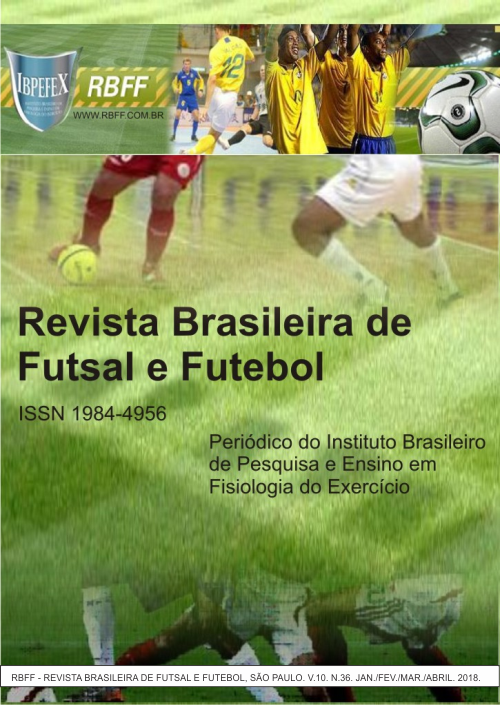Evaluation of pre-training food consumption by society soccer players
Abstract
This is a field research, cross-over, held during stage undergraduate degree in nutrition. The sample consisted of a group of 49 society soccer players, male, a club in the city of São Paulo. The athletes studied were sub 13 and sub 15 categories and aged between 11 and 15 years. It was asked to athletes foods, liquids and supplements ingested up to four hours before training. Weight, height, BMI and body fat percentage showed heterogeneous results, considering minimum and maximum values.They were asked what they ate up to four hours before training. Although average BMI values present differences between the categories, the percentage of fat is similar, however, there is great heterogeneity among them, considering minimum and maximum values. No athlete was classified as underweight and most is eutrophic. The consumption of all macronutrients in g / kg, is less in sub 15 than in sub 13. Most athletes consumed, in the 4 hours before training, carbohydrates within the recommendations (1-4 g / kg) and proteins and lipids above 0.4g / kg and 0.3g / kg, respectively. Thus, it is concluded that the monitoring of a dietitian to ensure adequate food pre-training football players athletes use to improve health and performance is necessary.
References
-Brant, A. C. A. Analise da ingestão pré-jogo em atletas profissionais de futebol. Revista Brasileira de Futsal e Futebol. Vol. 3. Num. 8. p. 142-150. 2011. Disponível em: <http://www.rbff.com.br/index.php/rbff/article/view/90/97>
-Caparros, D. R.; Baye, A. S.; Rodrigues, F.; Stulbach, T. E.; Navarro, F. Análise da adequação do consumo de carboidratos antes, durante e após treino e do consumo de proteínas após treino em praticantes de musculação de uma academia de Santo André-SP. Revista Brasileira de Nutrição Esportiva. Vol. 9. Num. 52. p. 298-306. 2015.Disponível em: <http://www.rbne.com.br/index.php/rbne/article/view/542/484>
-Cyrino, P.; Gauss, A. D.; Bernardes, R. A.; Gama, C. F. Consumo máximo de oxigênio e limiar anaeróbio de jogadores de futebol: comparação entre as diferentes posições. Rev. Bras. Med.do Esporte. Vol. 8. Núm. 2. p. 32-36. 1999.
-DC, ADN, ACSM. Nutrition and Athletic Performance: Position of Dietitians of Canada, the Academy of Nutrition and Dietetics and the American College of Sports Medicine. 2016.
-Dias, R. M. R.; Carvalho, F. O.; Souza, C. F.; Avelar, A. Altimare, L. R.; Cyrino, E. S. Caracteristicas antropométricas e de desempenho motor de atletas de futsal em diferentes categorias. Revista brasileira de cineantropologia e desempenho humano. Vol. 9. Num. 3. p. 297-302. 2007.
-Fortes, L. S.; Matta, M. O.; Paes, S. T.; Ferreira, M. E. C. Fatores de risco associados ao comportamento alimentar em futebolistas. Rev. bras. Educ. Fís. Esporte. Vol. 26. Num. 3. p. 447-454. 2012.
-Junior, V. L. M. C.; Souza, E. P.; Medeiros, L. F.; Brandão, D. C. Avaliação nutricional de atletas profissionais de futebol do Eusébio-Ceara. Revista Brasileira de Prescrição e Fisiologia do Exercício. Vol. 6. Num. 36. p. 535-542. 2012. Disponível em: <http://www.rbpfex.com.br/index.php/rbpfex/article/view/449/446>
-Lima,C. B. N.; Martins, M. E. F.; Liberali, R.; Navarro, F. Estado Nutricional e Composição Corporal de Jogadores de Futebol Profissional. Revista Brasileira de Nutrição Esportiva. Vol. 3. Num. 18. p. 562-569. 2015. Disponível em: <http://www.rbne.com.br/index.php/rbne/article/view/155/153>
-Martins, C. R.; Thomaz,G.; Matias, R.A.; Assis, M.; Pierucci, A.P. Hábitos alimentares e perfil antropométrico de atletas de futebol. XX Congresso brasileiro de Nutrição: Anais do XX Congresso Brasileiro de Nutrição. Vol. 2. Num. 1. 2009.
-Ormsbee, M. J.; Bach, C. W.; Baur, D. A. Pre-exercise nutrition: the roleof macronutrients, modified starches and supplements on metabolism and endurance performance. Nutrients. p. 1782-1808. 2014.
-Pontes, M.; Crauen, R. P.; Dickinson, L. A.; Kinch, R. F. T.; Ramsbottom, R.; apud Guerra, I. P. L.; Barros, N. T.; Tirapegui,J. Necessidades dietéticas de jogadores de futebol: uma revisão. Rev. Soc. Bras. Alim. Nutr. S. Vol. 28. p. 79-90. 2006.
-Prado, W. L.; Botero, J. P.; Guerra, R. L. F.; Rodrigues, C. L.; Cuvello, L. C.; Dâmasco, A. R. Perfil antropométrico e ingestão de macronutrientes em atletas profissionais brasileiros de futebol, de acordo com suas posições. Revista brasileira de medicina do esporte. Vol. 12. Num. 2.2006.
-SBME. Modificações dietéticas, reposição hídrica, suplementos alimentares e drogas: comprovação de ação ergogênica e potenciais riscos para a saúde. Rev Bras Med Esporte. Vol. 15. Num. 3. p. 3-12. 2009.
-SDA. Sports Dietitians Australia Position Statement: Sports Nutrition for the Adolescent Athlete. Vol. 24. Num. 1. p. 570-584. 2014.
-Spriet, L.L. New insights to the interaction of carboidrate and fat metabolism during exercise. Sports Med. Vol. 44. Suppl. p. 87-96. 2014.
-Sundgot-Borge, J.; Meyes, N.L.; Lohman, T.G.; Ackland, T.R.; Maughan, R. J.; Stewart, A.D.; Muller, W. How tominimize the health risks to athletes who compete in weight-senstive sports review and position statement on behalf of the Ad Hoc Research Working Group on Body Composition, Health and Performance, under the auspices of the IOC Medical Commission. Br. J. Sports Med. Vol.47. Num. 16. p. 10122-10122. 2013.
-Weineck, J.Biologia do esporte. Manole. 2000.
Authors who publish in this journal agree to the following terms:
- Authors retain the copyright and grant the journal the right of first publication, with work simultaneously licensed under the Creative Commons Attribution License BY-NC which allows the sharing of the work with acknowledgment of the authorship of the work and initial publication in this journal.
- Authors are authorized to enter into additional contracts separately for non-exclusive distribution of the version of the work published in this journal (eg, publishing in institutional repository or book chapter), with acknowledgment of authorship and initial publication in this journal.
- Authors are allowed and encouraged to post and distribute their work online (eg, in institutional repositories or on their personal page) at any point before or during the editorial process, as this can bring about productive change as well as increase impact and impact. citation of published work (See The Effect of Free Access).





